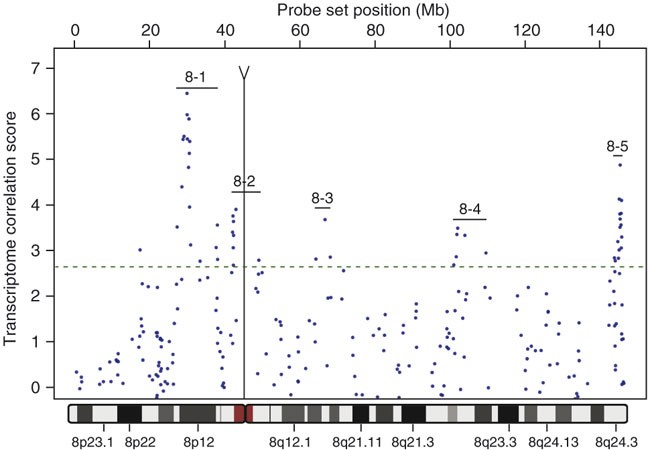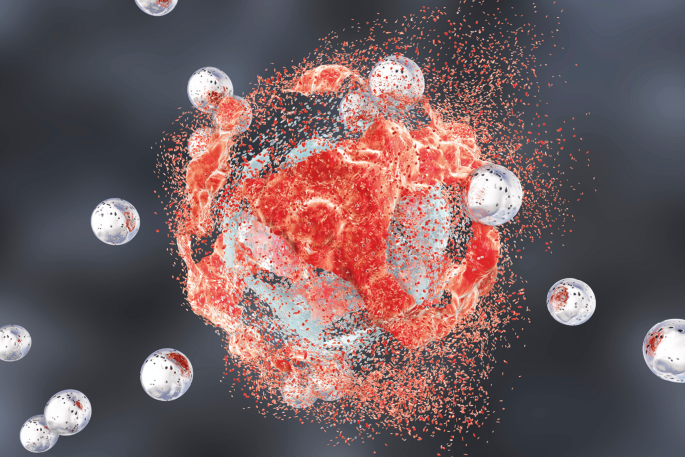
- Select a language for the TTS:
- UK English Female
- UK English Male
- US English Female
- US English Male
- Australian Female
- Australian Male
- Language selected: (auto detect) - EN
Play all audios:
ABSTRACT Genetic and epigenetic alterations have been identified that lead to transcriptional deregulation in cancers. Genetic mechanisms may affect single genes or regions containing
several neighboring genes, as has been shown for DNA copy number changes. It was recently reported that epigenetic suppression of gene expression can also extend to a whole region; this is
known as long-range epigenetic silencing. Various techniques are available for identifying regional genetic alterations, but no large-scale analysis has yet been carried out to obtain an
overview of regional epigenetic alterations. We carried out an exhaustive search for regions susceptible to such mechanisms using a combination of transcriptome correlation map analysis and
array CGH data for a series of bladder carcinomas. We validated one candidate region experimentally, demonstrating histone methylation leading to the loss of expression of neighboring genes
without DNA methylation. Access through your institution Buy or subscribe This is a preview of subscription content, access via your institution ACCESS OPTIONS Access through your
institution Subscribe to this journal Receive 12 print issues and online access $209.00 per year only $17.42 per issue Learn more Buy this article * Purchase on SpringerLink * Instant access
to full article PDF Buy now Prices may be subject to local taxes which are calculated during checkout ADDITIONAL ACCESS OPTIONS: * Log in * Learn about institutional subscriptions * Read
our FAQs * Contact customer support SIMILAR CONTENT BEING VIEWED BY OTHERS EPIGENETIC REGULATION DURING CANCER TRANSITIONS ACROSS 11 TUMOUR TYPES Article Open access 01 November 2023
INTEGRATIVE PAN CANCER ANALYSIS REVEALS EPIGENOMIC VARIATION IN CANCER TYPE AND CELL SPECIFIC CHROMATIN DOMAINS Article Open access 03 March 2021 HERITABLE TRANSCRIPTIONAL DEFECTS FROM
ABERRATIONS OF NUCLEAR ARCHITECTURE Article Open access 07 June 2023 ACCESSION CODES ACCESSIONS GENBANK/EMBL/DDBJ * E-TABM-147 CHANGE HISTORY * _ 27 FEBRUARY 2008 In the version of this
article initially published, the horizontal dashed lines representing the threshold value in the panels in row b of Figures 2 and 4 were incorrectly placed. The errors have been corrected in
the HTML and PDF versions of this article. _ REFERENCES * Solinas-Toldo, S. et al. Matrix-based comparative genomic hybridization: biochips to screen for genomic imbalances. _Genes
Chromosom. Cancer_ 20, 399–407 (1997). Article CAS Google Scholar * Pinkel, D. et al. High resolution analysis of DNA copy number variation using comparative genomic hybridization to
microarrays. _Nat. Genet._ 20, 207–211 (1998). Article CAS Google Scholar * Hughes, T.R. et al. Widespread aneuploidy revealed by DNA microarray expression profiling. _Nat. Genet._ 25,
333–337 (2000). Article CAS Google Scholar * Hyman, E. et al. Impact of DNA amplification on gene expression patterns in breast cancer. _Cancer Res._ 62, 6240–6245 (2002). CAS PubMed
Google Scholar * Pollack, J.R. et al. Microarray analysis reveals a major direct role of DNA copy number alteration in the transcriptional program of human breast tumors. _Proc. Natl. Acad.
Sci. USA_ 99, 12963–12968 (2002). Article CAS Google Scholar * Masayesva, B.G. et al. Gene expression alterations over large chromosomal regions in cancers include multiple genes
unrelated to malignant progression. _Proc. Natl. Acad. Sci. USA_ 101, 8715–8720 (2004). Article CAS Google Scholar * Heidenblad, M. et al. Microarray analyses reveal strong influence of
DNA copy number alterations on the transcriptional patterns in pancreatic cancer: implications for the interpretation of genomic amplifications. _Oncogene_ 24, 1794–1801 (2005). Article CAS
Google Scholar * Crawley, J.J. & Furge, K.A. Identification of frequent cytogenetic aberrations in hepatocellular carcinoma using gene-expression microarray data. _Genome Biol._ 3,
RESEARCH0075 (2002). Article Google Scholar * Zhou, Y. et al. Genome-wide identification of chromosomal regions of increased tumor expression by transcriptome analysis. _Cancer Res._ 63,
5781–5784 (2003). CAS PubMed Google Scholar * Kano, M. et al. Expression imbalance map: a new visualization method for detection of mRNA expression imbalance regions. _Physiol. Genomics_
13, 31–46 (2003). Article CAS Google Scholar * Midorikawa, Y. et al. Distinct chromosomal bias of gene expression signatures in the progression of hepatocellular carcinoma. _Cancer Res._
64, 7263–7270 (2004). Article CAS Google Scholar * Furge, K.A., Dykema, K.J., Ho, C. & Chen, X. Comparison of array-based comparative genomic hybridization with gene expression-based
regional expression biases to identify genetic abnormalities in hepatocellular carcinoma. _BMC Genomics_ 6, 67 (2005). Article Google Scholar * Yang, X.J. et al. A molecular classification
of papillary renal cell carcinoma. _Cancer Res._ 65, 5628–5637 (2005). Article CAS Google Scholar * Fujii, T. et al. A preliminary transcriptome map of non-small cell lung cancer.
_Cancer Res._ 62, 3340–3346 (2002). CAS PubMed Google Scholar * Cohen, B.A., Mitra, R.D., Hughes, J.D. & Church, G.M. A computational analysis of whole-genome expression data reveals
chromosomal domains of gene expression. _Nat. Genet._ 26, 183–186 (2000). Article CAS Google Scholar * Spellman, P.T. & Rubin, G.M. Evidence for large domains of similarly expressed
genes in the _Drosophila_ genome. _J. Biol._ 1, 5 (2002). Article Google Scholar * Reyal, F. et al. Visualizing chromosomes as transcriptome correlation maps: evidence of chromosomal
domains containing co-expressed genes–a study of 130 invasive ductal breast carcinomas. _Cancer Res._ 65, 1376–1383 (2005). Article CAS Google Scholar * Yi, Y., Mirosevich, J., Shyr, Y.,
Matusik, R. & George, A.L., Jr . Coupled analysis of gene expression and chromosomal location. _Genomics_ 85, 401–412 (2005). Article CAS Google Scholar * Frigola, J. et al.
Epigenetic remodeling in colorectal cancer results in coordinate gene suppression across an entire chromosome band. _Nat. Genet._ 38, 540–549 (2006). Article CAS Google Scholar * Turner,
B.M. Cellular memory and the histone code. _Cell_ 111, 285–291 (2002). Article CAS Google Scholar * Nguyen, C.T. et al. Histone H3-lysine 9 methylation is associated with aberrant gene
silencing in cancer cells and is rapidly reversed by 5-aza-2'-deoxycytidine. _Cancer Res._ 62, 6456–6461 (2002). CAS PubMed Google Scholar * Daigo, Y. et al. Molecular cloning of a
candidate tumor suppressor gene, DLC1, from chromosome 3p21.3. _Cancer Res._ 59, 1966–1972 (1999). CAS PubMed Google Scholar * Nakamura, Y. et al. Phospholipase Cdelta1 is required for
skin stem cell lineage commitment. _EMBO J._ 22, 2981–2991 (2003). Article CAS Google Scholar * Chambeyron, S. & Bickmore, W.A. Chromatin decondensation and nuclear reorganization of
the HoxB locus upon induction of transcription. _Genes Dev._ 18, 1119–1130 (2004). Article CAS Google Scholar * Huebert, D.J. & Bernstein, B.E. Genomic views of chromatin. _Curr.
Opin. Genet. Dev._ 15, 476–481 (2005). Article CAS Google Scholar * Gialitakis, M. et al. Coordinated changes of histone modifications and HDAC mobilization regulate the induction of MHC
class II genes by trichostatin A. _Nucleic Acids Res._ 34, 765–772 (2006). Article CAS Google Scholar * Bird, A. DNA methylation patterns and epigenetic memory. _Genes Dev._ 16, 6–21
(2002). Article CAS Google Scholar * van Driel, R., Fransz, P.F. & Verschure, P.J. The eukaryotic genome: a system regulated at different hierarchical levels. _J. Cell Sci._ 116,
4067–4075 (2003). Article CAS Google Scholar * Zardo, G. et al. Integrated genomic and epigenomic analyses pinpoint biallelic gene inactivation in tumors. _Nat. Genet._ 32, 453–458
(2002). Article CAS Google Scholar * Hurst, L.D., Pal, C. & Lercher, M.J. The evolutionary dynamics of eukaryotic gene order. _Nat. Rev. Genet._ 5, 299–310 (2004). Article CAS
Google Scholar * Sproul, D., Gilbert, N. & Bickmore, W.A. The role of chromatin structure in regulating the expression of clustered genes. _Nat. Rev. Genet._ 6, 775–781 (2005). Article
CAS Google Scholar * Chang, H.Y. et al. Gene expression signature of fibroblast serum response predicts human cancer progression: similarities between tumors and wounds. _PLoS Biol._ 2,
E7 (2004). Article Google Scholar * Diez de Medina, S.G. et al. Decreased expression of keratinocyte growth factor receptor in a subset of human transitional cell bladder carcinomas.
_Oncogene_ 14, 323–330 (1997). Article CAS Google Scholar * Chirgwin, J.M., Przybyla, A.E., MacDonald, R.J. & Rutter, W.J. Isolation of biologically active ribonucleic acid from
sources enriched in ribonuclease. _Biochemistry_ 18, 5294–5299 (1979). Article CAS Google Scholar * Coombs, L.M. et al. Simultaneous isolation of DNA, RNA, and antigenic protein
exhibiting kinase activity from small tumor samples using guanidine isothiocyanate. _Anal. Biochem._ 188, 338–343 (1990). Article CAS Google Scholar * Labarca, C. & Paigen, K. A
simple, rapid, and sensitive DNA assay procedure. _Anal. Biochem._ 102, 344–352 (1980). Article CAS Google Scholar * Snijders, A.M. et al. Genome-wide-array-based comparative genomic
hybridization reveals genetic homogeneity and frequent copy number increases encompassing CCNE1 in fallopian tube carcinoma. _Oncogene_ 22, 4281–4286 (2003). Article CAS Google Scholar *
Jain, A.N. et al. Fully automatic quantification of microarray image data. _Genome Res._ 12, 325–332 (2002). Article CAS Google Scholar * Neuvial, P. et al. Spatial normalization of
array-CGH data. _BMC Bioinformatics_ 7, 264 (2006). Article Google Scholar * Hupé, P., Stransky, N., Thiery, J.P., Radvanyi, F. & Barillot, E. Analysis of array CGH data: from signal
ratio to gain and loss of DNA regions. _Bioinformatics_ 20, 3413–3422 (2004). Article Google Scholar * Southgate, J., Hutton, K.A., Thomas, D.F. & Trejdosiewicz, L.K. Normal human
urothelial cells in vitro: proliferation and induction of stratification. _Lab. Invest._ 71, 583–594 (1994). CAS PubMed Google Scholar * Xiong, Z. & Laird, P.W. COBRA: a sensitive and
quantitative DNA methylation assay. _Nucleic Acids Res._ 25, 2532–2534 (1997). Article CAS Google Scholar * O'Neill, L.P. & Turner, B.M. Immunoprecipitation of native chromatin:
NChIP. _Methods_ 31, 76–82 (2003). Article CAS Google Scholar * Kent, W.J. BLAT–the BLAST-like alignment tool. _Genome Res._ 12, 656–664 (2002). Article CAS Google Scholar * R
development core team _R: a Language and Environment for Statistical Computing_. (R Foundation for Statistical Computing, Vienna, 2006). Download references ACKNOWLEDGEMENTS We thank C.
Rouveirol for discussions, P. Hupé for his GLAD algorithm expertise and the Institut Curie Bioinformatics Service headed by E. Barillot for support. We also thank J. Sappa from Alex Edelman
& Associates for careful reading of the manuscript and the UCSF Cancer Center Array CGH Core for providing the BAC arrays. This article is dedicated to the memory of D. Chopin, whose
commitment to cancer research was of paramount importance for the initiation of this work. This work was supported by the CNRS, the Institut Curie, AstraZeneca, the Canceropole Ile de France
and the Ligue Nationale Contre le Cancer. N.S., C.V., F. Reyal, I.B.-P., S.G.D. de M. and F. Radvanyi are members of the Equipe Oncologie Moléculaire, labellisée par La Ligue Nationale
Contre le Cancer. N.S. was supported by a fellowship from the French Ministry of Education and Research and a fellowship from the Association pour la Recherche sur le Cancer. C.V. was
supported by a fellowship from the French Ministry of Education and Research and F. Reyal by a fellowship from the Ligue Nationale Contre le Cancer. AUTHOR INFORMATION Author notes *
Dominique K Chopin: Deceased. * Nicolas Stransky and Céline Vallot: These authors contributed equally to this work. AUTHORS AND AFFILIATIONS * UMR 144 Centre National de la Recherche
Scientifique (CNRS)/Institut Curie, Paris, 75248 Cedex 05, France Nicolas Stransky, Céline Vallot, Fabien Reyal, Isabelle Bernard-Pierrot, Sixtina Gil Diez de Medina, Jean Paul Thiery &
François Radvanyi * EMI Institut National de la Santé et de la Recherche Médicale (INSERM) 03-37, Hôpital Henri Mondor, Créteil, 94010, Cedex, France Sixtina Gil Diez de Medina, Yves Allory,
Claude C Abbou & Dominique K Chopin * Comprehensive Cancer Center, University of California San Francisco (UCSF), San Francisco, 94143, California, USA Rick Segraves, Donna G Albertson
& Daniel Pinkel * Department of Biostatistics, Institut Curie, Paris, 75248 Cedex 05, France Yann de Rycke & Bernard Asselain * Cancer and Infection Research Area, AstraZeneca,
Mereside, Alderley Park, Macclesfield, SK10 4TG, Cheshire, UK Paul Elvin, Andrew Cassidy, Carolyn Spraggon & Alexander Graham * Department of Biology, Jack Birch Unit of Molecular
Carcinogenesis, University of York, Heslington, YO10 5DD, York, UK Jennifer Southgate * Department of Pathology, Hôpital Henri Mondor, Créteil, 94010, Cedex, France Yves Allory * Department
of Urology, Hôpital Henri Mondor, Créteil, 94010, Cedex, France Claude C Abbou & Dominique K Chopin * Cancer Research Institute, UCSF, San Francisco, 94143, California, USA Donna G
Albertson * Department of Translational Research, Institut Curie, Paris, 75248, Cedex 05, France Jean Paul Thiery * Institute of Molecular and Cell Biology, Proteos, 138673, Singapore Jean
Paul Thiery Authors * Nicolas Stransky View author publications You can also search for this author inPubMed Google Scholar * Céline Vallot View author publications You can also search for
this author inPubMed Google Scholar * Fabien Reyal View author publications You can also search for this author inPubMed Google Scholar * Isabelle Bernard-Pierrot View author publications
You can also search for this author inPubMed Google Scholar * Sixtina Gil Diez de Medina View author publications You can also search for this author inPubMed Google Scholar * Rick Segraves
View author publications You can also search for this author inPubMed Google Scholar * Yann de Rycke View author publications You can also search for this author inPubMed Google Scholar *
Paul Elvin View author publications You can also search for this author inPubMed Google Scholar * Andrew Cassidy View author publications You can also search for this author inPubMed Google
Scholar * Carolyn Spraggon View author publications You can also search for this author inPubMed Google Scholar * Alexander Graham View author publications You can also search for this
author inPubMed Google Scholar * Jennifer Southgate View author publications You can also search for this author inPubMed Google Scholar * Bernard Asselain View author publications You can
also search for this author inPubMed Google Scholar * Yves Allory View author publications You can also search for this author inPubMed Google Scholar * Claude C Abbou View author
publications You can also search for this author inPubMed Google Scholar * Donna G Albertson View author publications You can also search for this author inPubMed Google Scholar * Jean Paul
Thiery View author publications You can also search for this author inPubMed Google Scholar * Dominique K Chopin View author publications You can also search for this author inPubMed Google
Scholar * Daniel Pinkel View author publications You can also search for this author inPubMed Google Scholar * François Radvanyi View author publications You can also search for this author
inPubMed Google Scholar CORRESPONDING AUTHOR Correspondence to François Radvanyi. ETHICS DECLARATIONS COMPETING INTERESTS The authors declare no competing financial interests. SUPPLEMENTARY
INFORMATION SUPPLEMENTARY FIG. 1 Transcriptome correlation maps of all chromosomes for the 57 bladder carcinomas. (PDF 1711 kb) SUPPLEMENTARY FIG. 2 Quantitative PCR analysis of the gene
copy number of region 3-2. (PDF 33 kb) SUPPLEMENTARY TABLE 1 Transcriptome correlation map of 57 bladder carcinomas for chromosomes 1 to X (PDF 130 kb) SUPPLEMENTARY TABLE 2 Clinical data of
the 57 bladder carcinomas. (PDF 42 kb) SUPPLEMENTARY TABLE 3 Primers for quantitative PCR, COBRA and ChIP experiments. (PDF 45 kb) SUPPLEMENTARY NOTE (PDF 42 KB) RIGHTS AND PERMISSIONS
Reprints and permissions ABOUT THIS ARTICLE CITE THIS ARTICLE Stransky, N., Vallot, C., Reyal, F. _et al._ Regional copy number–independent deregulation of transcription in cancer. _Nat
Genet_ 38, 1386–1396 (2006). https://doi.org/10.1038/ng1923 Download citation * Received: 09 August 2006 * Accepted: 13 October 2006 * Published: 12 November 2006 * Issue Date: 01 December
2006 * DOI: https://doi.org/10.1038/ng1923 SHARE THIS ARTICLE Anyone you share the following link with will be able to read this content: Get shareable link Sorry, a shareable link is not
currently available for this article. Copy to clipboard Provided by the Springer Nature SharedIt content-sharing initiative






